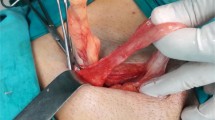Abstract
Background
Postoperative fluid collection in the space left behind the dissected hernia sac in laparoscopic herniorraphy puts the surgeon in a dilemma as to whether it is a recurrence or a seroma, and it is not always easily judged only by physical examination (PE). Another important issue is what kind of seroma can be accepted as a complication of surgery.
Methods
Thirty patients with unilateral inguinal hernia who had a hernia sac of >4 cm were operated on with transabdominal preperitoneal hernia repair (TAPP) technique and the collection at the hernia site was followed by PE and superficial ultrasonography (USG) postoperatively on the first day, first week, first month, and third month.
Results
USG detected seroma in 20 patients, while 17 could be noticed by PE on the first postoperative day. At the end of the third month, seromas resolved by 90%, and could only be detected by USG in two patients. Pain or complication rates attributable to seroma in patients were not determined (p > 0.05) in the statistical analyses between the groups.
Conclusions
Superficial USG is a beneficial tool in differentiating early recurrence or seroma in patients. It should not be intervened with as a complication until the patient has complaints attributable to seroma.



Similar content being viewed by others
References
Aeberhard P, Klaiber C, Meyenberg A, Osterwalder A, Tschudi J (1999) Prospective audit of laparoscopic totally extraperitoneal inguinal hernia repair: a multicenter study of the Swiss Association for Laparoscopic and Thoracoscopic Surgery (SALTC). Surg Endosc 13: 1115–1120
Andersson B, Hallen M, Leveau P, Bergenfelz A, Westerdahl J (2003) Laparoscopic extraperitoneal inguinal hernia repair versus open mesh repair: a prospective randomized controlled trial. Surgery 133: 464–472
Bendavid R, Kux M (2001) Seromas. In: Bendavid R, Abrahamson J, Arregui ME, Flament JB, Phillips EH, eds. Abdominal wall hernias: principles and management. Springer, New York, pp 753–756
Bringman S, Ramel S, Heikkinen TJ, Englund T, Westman B, Anderberg B (2003) Tension-free inguinal hernia repair: TEP versus mesh-plug versus Lichtenstein: a prospective randomized controlled trial. Ann Surg 237: 142–147
Colak T, Akca T, Kanik A, Aydin S (2003) Randomized clinical trial comparing laparoscopic totally extraperitoneal approach with open mesh repair in inguinal hernia. Surg Laparosc Endosc Percutan Tech 13: 191–195
Demirbas S, Ogun I, Akta O, Kurt Y, Yildiz M, Akin ML, Celenk T (2003) Hernia operations using laparoscopic hernioplasty on military personnel with a short hospitalization time. Mil Med 168: 835–839
Ferzli GS, Kiel T (1997) The role of the endoscopic extraperitoneal approach in large inguinal scrotal hernias. Surg Endosc 11: 299–302
Fitzgibbons RJ Jr, Camps J, Cornet DA, Nguyen NX, Litke BS, Annibali R, Salerno GM (1995) Laparoscopic inguinal herniorrhaphy. Results of a multicenter trial. Ann Surg 221: 3–13
Gokalp A, Inal M, Maralcan G, Baskonus I (2003) A prospective randomized study of Lichtenstein open tension-free versus laparoscopic totally extraperitoneal techniques for inguinal hernia repair. Acta Chir Belg 103: 502–506
Heniford BT, Park A, Ramshaw BJ, Voeller G (2000) Laparoscopic ventral and incisional hernia repair in 407 patients. J Am Coll Surg 190: 645–650
Kapiris SA, Brough WA, Royston CM, O'Boyle C, Sedman PC (2001) Laparoscopic transabdominal preperitoneal (TAPP) hernia repair. A 7-year two-center experience in 3017 patients. Surg Endosc 15: 972–975
Kumar S, Wilson RG, Nixon SJ, Macintyre IM (2002) Chronic pain after laparoscopic and open mesh repair of groin hernia. Br J Surg 89: 1476–1479
Lau H, Lee F (2003) Seroma following endoscopic extraperitoneal inguinal hernioplasty. Surg Endosc 17: 1773–1777
Leibl BJ, Schmedt CG, Kraft K, Ulrich M, Bittner R (2000) Scrotal hernias: a contraindication for an endoscopic procedure? Results of a single-institution experience in transabdominal preperitoneal repair. Surg Endosc 14: 289–292
Litwin DE, Pham QN, Oleniuk FH, Kluftinger AM, Rossi L (1997) Laparoscopic groin hernia surgery: the TAPP procedure. Transabdominal preperitoneal hernia repair. Can J Surg 40: 192–198
Park A, Birch DW, Lovrics P (1998) Laparoscopic and open incisional hernia repair: a comparison study. Surgery 124: 816–821; discussion 821–812
Ramshaw B, Shuler FW, Jones HB, Duncan TD, White J, Wilson R, Lucas GW, Mason EM (2001) Laparoscopic inguinal hernia repair: lessons learned after 1224 consecutive cases. Surg Endosc 15: 50–54
Schwab JR, Beaird DA, Ramshaw BJ, Franklin JS, Duncan TD, Wilson RA, Miller J, Mason EM (2002) After 10 years and 1903 inguinal hernias, what is the outcome for the laparoscopic repair? Surg Endosc 16: 1201–1206
Susmallian S, Gewurtz G, Ezri T, Charuzi I (2001) Seroma after laparoscopic repair of hernia with PTFE patch: is it really a complication? Hernia 5: 139–141
Author information
Authors and Affiliations
Corresponding author
Rights and permissions
About this article
Cite this article
Cihan, A., Ozdemir, H., Uçan, B.H. et al. Fade or fate. Surg Endosc 20, 325–328 (2006). https://doi.org/10.1007/s00464-005-0052-6
Received:
Accepted:
Published:
Issue Date:
DOI: https://doi.org/10.1007/s00464-005-0052-6




